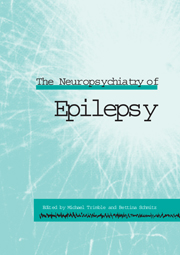Book contents
- Frontmatter
- Contents
- List of contributors
- Part I Background
- Part II Clinical aspects
- Part III Cognitive aspects
- Part IV Nonepileptic attacks
- Part V Treatment complications
- Part VI Treatment
- 20 On the use of psychotropic drugs in patients with seizure disorder
- 21 The role of psychotherapy in the treatment of epilepsies
- 22 Choosing measures to assess quality of life (QOL) in epilepsy
- Index
21 - The role of psychotherapy in the treatment of epilepsies
Published online by Cambridge University Press: 05 October 2010
- Frontmatter
- Contents
- List of contributors
- Part I Background
- Part II Clinical aspects
- Part III Cognitive aspects
- Part IV Nonepileptic attacks
- Part V Treatment complications
- Part VI Treatment
- 20 On the use of psychotropic drugs in patients with seizure disorder
- 21 The role of psychotherapy in the treatment of epilepsies
- 22 Choosing measures to assess quality of life (QOL) in epilepsy
- Index
Summary
Introduction
The use of psychotherapy in epilepsy is a complicated topic, because it always has to take into account the neurological dimension of the underlying epileptic disorder as well as the specific psychiatric vulnerability epilepsy engenders. As a result, the following cannot provide a simple set of treatment rules. Instead, it presents:
Introductory comments on the complex relation between (neurological) epileptological and psychotherapeutic approaches.
This is followed by four case reports to give some idea of how the general rules of diagnosis have to be applied in an individual way to produce a unique treatment in every single case.
Then, some ideas are presented on indications and contraindications.
Finally, findings from a posttreatment comparison of conventional inpatient treatment of epilepsy vs. treatment supplemented by psychotherapy are reported to help decide whether psychotherapy is in any way effective in treating epilepsy or is only well-intended.
Despite the above-mentioned complexity, it is easy to gain an overview on psychotherapy in the treatment of epilepsy because there seems to be practically no recent literature on the topic. The indices of major modern textbooks on epileptology refer to psychotherapies exclusively in connection with pseudoseizures (Engel and Pedley, 1997) or give, at best, the terse reference that ‘ this modality is largely neglected in the literature on epilepsy for several reasons’ (Stagno, 1993, p. 1154). Except for pseudoseizures, psychotherapeutic procedures have not been addressed in any relevant epileptological journals during the last 10 years.
- Type
- Chapter
- Information
- The Neuropsychiatry of Epilepsy , pp. 313 - 322Publisher: Cambridge University PressPrint publication year: 2002



